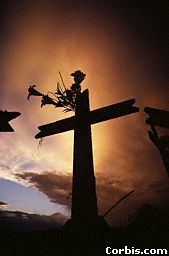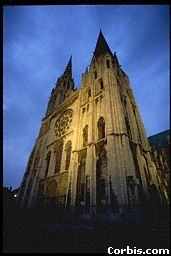| In Christian lands the greatest religious festival of the year is Easter. It takes place on the first Sunday following the full moon that appears on or after the vernal equinox, about March 21. It is preceded by the six weeks on Ash Wednesday, a period of fasting set aside for mourning the trial and crucifixion of Christ. The season ends on Easter--a joyous day commemorating Christ's resurrection and ascension into heaven. The churches are filled to overflowing with people dressed in ne Easter costumes; the altars are banked with lilies and spring flowers; and the choir and congregation join in singing joyous hymns and anthems. Easter is also a springtime festival, and many customs and legends are pagan in origin and have nothing to do with Christianity. The name Easter comes from the Scandinavian "Ostra" and the Teutonic "Ostern", both goddesses of mythology signifying the coming of spring. Like all spring festivals of ancient origin, the celebration is closely tied to nature worship; for instance, the symbolic use of eggs and the Easter hare both have a mystical background. Even the ancients knew that all elemental matter is oval-shaped, from the rain drop to the seed, therefore, the Easter egg pays tribute to life's outgrowth of the ancient pagan sacramental cakes eaten by Anglo-Saxons in honor of their goddess, and the Cross is a symbol of many creeds. |
 |
 |
| Easter |
| Sunrise Services It was a common belief among the early Christians that on Easter morning the sun danced in honor of the resurrection and people rose long before the sun to see the feat. Perhaps this ancient belief is the inspiration for the many sunrise services that take place in all parts of the US on Easter morning. The first such service on record was held by the Moravians in Winston-Salem, North Carolina, in 1773, and it has always been the custom for people in Newport, Rhode Island, to gather along the shore on Narragansett Bay to watch the sun rise up out of the water. The Easter Parade The traditional Easter parade goes back thousands of years when Constantine commanded his council to bedeck themselves in their more elegant robes to observe the day to honor Christ's resurrection. Coupled with this was a popular belief that one must wear for the first time on Easter Sunday a new article of |
| clothing to ensure good fortune for the rest of the year. In the US the Easter parade has a different meaning. People enjoy taking off their heavy clothes and donning fresh, light ones of spring and they like to see the Easter parade of gaily dressed worshipers strolling home from church. Since most of the participants attend church, the parade is scheduled to take place at noon, or at a time when most of the services are over. The Easter Rabbit Why the Easter rabbit hippety-hops into the Easter picture has many mystical explanations. In the Orient, the Easter here is very closely associated with the new moon, and Japanese artists paint the hare across the moon's disc. The Chinese represent the moon as a rabbit pounding rice in a mortar. The Europeans also have all sorts of fantasies connected with the moon, but the most accepted theory is that it represents fertility. However, we like the old belief that on Easter Sunday a rabbit, after a long winter's sleep, lays bright red and blue, yellow and purple eggs in the new grass. In Germany, it is the Easter hare that brings the eggs and hides them in the house and garden for chidlren to search for. In many places pretty little rabbit gardens are made ready for the hare. In France and other Catholic countries, the children are taught that eggs are brought, not by rabbits, but by bells. After Mass on Holy Thursday, the bells fly to Rome to fetch eggs which, on their return, they drop in children's houses and gardens. As no Mass is held and no bells are rung, it is reasonable to think that the bells are away. During this time the bells sleep on the roof of St. Peter's. |
Hot Cross Buns On the first day of Lent pans of hot cross buns are featured in most bakeries throughout the country. Surprisingly, these delicious buns are generally sold only during the six weeks preceding Easter, thus preserving their Christian significance. The buns were given Christian meaning by being blessed and decorated with a cross. The Italian Tortona, which has its counterpart in many countries, is a twist of dough baked around a colored egg. |
| The word "bun" itself derives from boun, Saxon for "sacred ox", for an ox was sacrificed at the Easter festival, and the image of its horns was carved into the celebratory cakes. The Easter treat was widespread in the early Western world. "Hot cross buns" were found preserved in the excavations at the ancient city of Herculaneum, destroyed in A.D. 79 along with Pompeii by the eruption of Mount Vesuvius. Early church fathers, to compete with the pagan custom of baking ox marked cakes, used in numerous celebrations, baked their own version, employing the dough used for the consecrated host. Reinterpreting the ox horn image as a crucifix, they distributed the somewhat-familiar-looking buns to new converts attending Mass. In this way, they accomplished three objectives: Christianized a pagan cake; gave the people a treat they were accustomed to; and subtly scored the buns with an image that, though decidedly Catholic, at a distance would not dangerously label the bearer "Christian". The most desirable image on today's hot cross buns is neither an ox horn nor a cross, but broad smears of glazed frosting. Easter Eggs The custom of using eggs in various ways has been associated with Easter for centuries. From earliest times, and in most cultures, the egg signified birth and ressurection. The Egyptians buried eggs in their tombs. The Greeks palced eggs atop graves. The Romans coined a proverb: "Omne vivum ex ovo--All life comes from an egg". In Europe, particularly in the Slavic countries, eggs are hand-painted in distinctive traditional designs that are passed down from generation to generation in towns and villages. The making of Easter eggs as presents was at one time almost universal. In parts of Germany during the early 1880s, Easter eggs substituted for birth certificates. An age was dyed a solid color, then a design, which included the recipient's name and birth date, was etched into the shell with a needle or sharp tool. Such Easter eggs were honored in law courts as evidence of identity and age. |